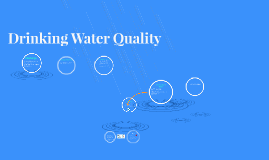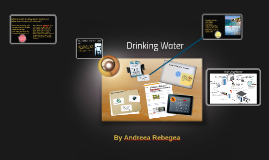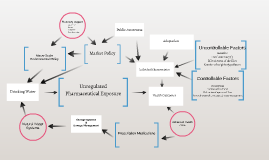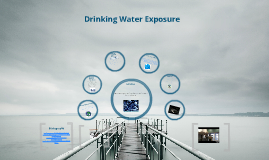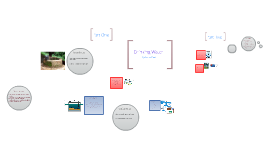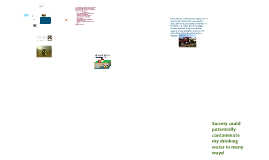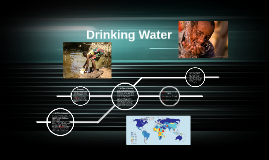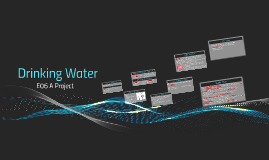Drinking Water
Transcript: Our well water test determined that there is no E. coli or Coliform present in our water. The Ausable Bayfield Conservation Authority has had the aquifer sampled showing concentrations of nitrate, chloride and fluoride to be well below provincial water maximum standards and may or may not even be present. (Schnaithmann). According to Gary Reavie (2012) of Davidson Well Drilling, any activity above the aquifer has the potential to affect my drinking water. "Because water is used and reused, and because it is such a powerful solvent, it is easily polluted. Pure water does not exist in nature. Water is a solution containing many different dissolved ions." (Mustoe, 2001, pp. 357-358). "Human activities causing compaction and degradation of soil reduce natural water purification ex. heavy farm equipment, building of structures." (Landry). Accidents on roads and railways involving chemical spills (gas, oil) and road salt can potentially get into our water. At the Holmesville landfill, rainwater percolates through landfill waste and dissolves numerous compounds, many of them toxic. (Mustoe, 2001, p. 358). Many activities and events that society is involved in can contaminate the environment and potentially pollute the drinking water, creating a health hazard! My septic system turns our waste water from the house into a cleaner solution that can be evenly distributed under the ground and mixed with ground water, without a risk of health problems. Waste water from the house enters the septic tank through a pipe. The septic tank has two sections. In the first section, the solids decompose and soaps and enzymes remain there. A wall separates the two sections, allowing only liquid into the second one. This liquid gets stirred up and is pushed out through a pipe to the tile bed by water displacement. This grey water moves through the tile bed via pipes with holes that let the water drip out into the tile stone, which is 60 centimetres deep. The tile stone and top soil filter the water. 60%-70% of the water going through the tile bed gets evaporated and purified. The ground filters the water more as it moves downward separating out the impurities. Eventually it reaches the aquifer. Each stage filters the water more. (McCullough). A septic system should be inspected annually and pumped regularly. With three people living in our home, our septic tank should be pumped every four years. Maintenance only plant grass near the septic system, roots could cause damage no driving on or heavy equipment don't build over the drainfield conserve water do not dispose of anything harmful through the system divert other sources of water (ex. roof drain) (Maintaining, 2004) Society could potentially contaminate my drinking water in many ways! "Air, water and soil can become polluted from vehicle emissions and factory smoke stacks. Acidic gasses produced, dissolve and contribute to the formation of acid rain. The concentrations of ions in ground water are affected by how acidic the water is. Acidic water increases the leaching of aluminum ions in the soil into rivers and lakes." (Mustoe, 2001, p. 358). Acidic gasses are solutes, which dissolve into rain water, which is a solvent. In the summer, Harvey Dale (2012), of H. T. Dale Septic Tank Service, spreads the material from septic tanks on his field. In the winter, he takes it to the sewage treatment plant, in the area that is capable of excepting the material. The material is not treated at all before disposal. Most things should NOT go down the drain! Some of these include, food scraps, grease, coffee grinds, cooking oil, kleenex, paper towels, cigarette butts, dental floss, chemicals, paint and antibacterial soaps. If something doesn't break down naturally, don't put it into the septic system. (Maintaining, 2004) My Septic System "My Drinking Water" I live on the Bayfield River. Phil Landry (2012) of the Huron County Health Unit states that, activities causing pollutants to enter the river could contaminate the aquifer our well draws water from. He said that contaminants can reach our drinking water through the ground. "Septic tank leakage, sewage treatment plant spills and leaking underground oil or gas tanks are possible contaminants", says Bill Rathwell (2012) of Rathwell & Rathwell Petroleum Handling Systems. Use of chemicals, such as weed spray or fertilizer, on lawns and golf courses are a threat to our water. Farming activities on and around our farm: Spreading chemical fertilizer (nitrates, phosphates) Spreading pesticides Spreading manure They could all potentially pollute surface water and may get into the ground water and aquifer by runoff or directly through the ground. (Schnaithmann). Man-made drainage systems increase the risk of contamination because of the concentration of water in a small area. This water gets into creeks and rivers more rapidly. "Septic systems and the ground filter out bacteria but not chemicals, such as gas and oil." (Landry). According to Steve






